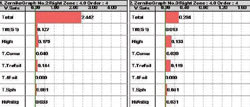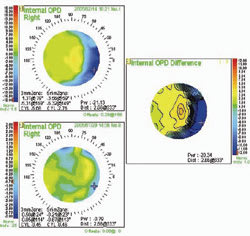spotlight on technology &
technique
Marco's
3-D Wave: Improved Efficiency and Precision in Refractive Care
By
Leslie Goldberg, Assistant Editor
Marco's 3-D Wave provides users with an instrument that can effectively evaluate a patient's total visual system. The 3-D Wave allows users to obtain refraction, corneal topography, pupillometry (photopic and mesopic), optical path difference mapping and wavefront analysis all with a single device. Additionally, the 3-D Wave provides doctors with a way to evaluate patients comprehensively, perform refractive and cataract surgery screening, evaluate postoperative complaints and determine pathology diagnoses.
Measuring both low- and high-order aberrations (HOA) on a single axis, the 3-D Wave gives users the power to diagnose patient complaints that simply would not be diagnosed before. The 3-D Wave has a dynamic spatial skiascopy wavefront aberrometer that can achieve a wavefront-guided HOA reading.
|
|
|
Figure 1. A Pre and postop Zernike graph displaying HOA corrections performed. |
3-D Wave Clinical Uses
Christopher Larson, M.D., of Larson EyeCare in Sheboygan, Wis., has been using the 3-D Wave since 2003. Dr. Larson purchased the system primarily to help in diagnosing patients with HOAs. The device also assists him in performing wavefront studies on anyone that has a need for LASIK surgery. "It is a nice way to help determine who gets conventional LASIK and who gets CustomView (Advanced Medical Optics [AMO]/Visx, Santa Ana, Calif.)," says Dr. Larson.
Dr. Larson also uses the 3-D Wave on patients postop to see if there is much change or induced HOA due to the flaps being made (Figure 1). "It is a way to test my skills and see if I am ending up with the kind of flaps that I want and the kind of healing that I want with very little HOA," says Dr. Larson.
The system provides Placido disc topography as well as dynamic spatial skiascopy wavefront aberrometry. Dr. Larson explains that there can be very subtle problems on the surface of the cornea and within the cornea, or even within the lens, creating HOAs that don't show up on any Placido disc or any other corneal topography.
"Something has to be used to help to define this occurrence," says Dr. Larson. "This machine uses dynamic sciascopy (automated retinoscopy) and optical path difference measurements, and comes up with a mathematical equation showing that light is focused better at this point than at this point." (Figure 2)
Additionally, the interaction of various maps on the 3-D Wave allows the practitioner to determine if the patient's optical complaint results from the anterior cornea, posterior cornea or the lens. Determination of the spherical aberration of the lens is important for cataract surgeons.
Getting the Vision Your Patients Demand
|
|
|
Figure 2. This difference map shows the decentration of the IOL in the patient's visual system and the correction after IOL lens exchange was performed. |
Dr. Larson says the system is extremely helpful in making decisions about patients that were not getting the level of vision that they wanted. "The 3-D Wave is a helpful way of taking a group of postop LASIK patients and saying, 'I think that you could see better if we did the following...'"
"A decade ago, the first thing we would do is a macular study to determine why someone wasn't seeing well. Now, we spend more time working on the cornea. You can see the macula, and know what vision it is capable of producing. It is very hard with the cornea — using a slit lamp to determine to say 'with this cornea, I should be seeing 20/20 or 20/30.' With the 3-D Wave, you can get a good look at the cornea and you can start making some correlations as to how this disease translates into this level of vision, and you can say 'I think I know what your problem is and we don't need to do an angiogram or OCT,'" says Dr. Larson. "With the 3-D Wave, I can tell whether the distortion is coming from the cornea or from the human lens or from a lens implant."
Additional Benefits
Dr. Larson says that the 3-D Wave is easy to use. "My staff has a wonderful understanding of it. It also takes some of the intuitiveness out of the equation," he says. "The staff is all trained in retinoscopy. They are able to put patients into a room and perform a full refraction. If they are a little puzzled by something, they do an autorefraction using the 3-D Wave and it is very accurate."
Applications of the 3-D Wave
► Evaluates all eyes not correctable to 20/20
► Differentiates corneal from lenticular aberrations
► Compares objective to subjective point spread function (PSF)
► Assesses cataract patients' symptoms and "quality" of vision
► Shows pre- and post-posterior capsular
opacification effects
► Evaluates postop IOL tilt, decentration, multifocal
optics
► Assesses contact-lens candidates for soft-
vs. hard-lens wear
► Evaluates corneal aberrations secondary to certain lid and ocular
surface pathologies
► Monitors progress and visual effects from varying ocular pathologies
and surgeries
► Assesses pre- and post-corneal refractive surgery patients
► Evaluates postop refractive surgery complaints (halo, glare). OM
For more information in the 3-D Wave, contact Marco at (800) 874-5274 or visit their Web site at www.marco.com.










